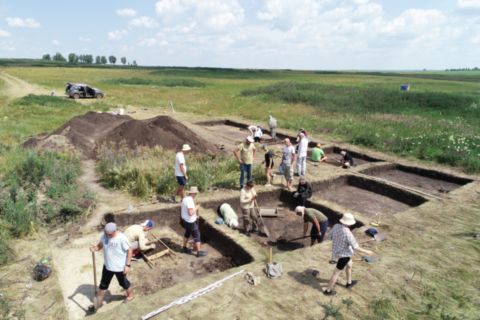SUSU archaeologists discovered an interesting find, a burial of a “wandering metallurgist”, dated back to the Bronze Age. It was found during excavations at burials of the Sintashta culture in the area of Krivoye Ozero in the Troitsky District of the Chelyabinsk Region. The result was published in the international journal “Archaeological and Anthropological Sciences” of the Springer Verlag publishing house. The research was supported by a grant from the Russian Science Foundation. We are talking about the find with the lead author of the study, Deputy Director of the Institute of Media, Social Sciences and Humanities, Doctor of Sciences (History) Andrei Epimakhov.
Archaeologists do not talk about ancient “peoples”, but rather about archaeological cultures united by common rituals, beliefs, geography, and kinship. The South Ural region is famous for the Sintashta culture of the Bronze Age. Arkaim, well-known throughout our country, belongs to it. In addition to Arkaim, dozens more settlements were discovered: Sintashta, Ustye, Kamenny Ambar, Stepnoye and others. In many cases, burial grounds were discovered along with settlements, among them the Krivoye Ozero necropolis, which was explored by Doctor of Historical Sciences Nikolai Vinogradov in the 1990s. Today's analytical capabilities have allowed us to take a completely different look at one of the burials, that had evidence of metallurgy.
Radiocarbon dating determined the time of burial: 1996-1881 BC.
The man lay in a separate burial. However, the burial ritual was typical for the Sintashta people - the same position of the body, the same sacrifice - clearly not a marginalized person, buried as a full-fledged member of society under the same mound with other members of the ancient collective. An analysis of the diet (based on nitrogen and carbon isotopes in the bones) has shown that the person ate the same foods as the other buried people of Krivoye Ozero - therefore, he lived in the same territory.
Like many others, he was buried along with his belongings, in the case of a craftsman - with materials and tools. There were ore, scrap metal for smelting, and fragments of slag cakes. This means that man mastered the art of producing metal from ore and casting.
He was quite unusual in appearance. His skull showed evidence of acromegaly, a genetic disease that makes facial features coarse. Height is average for Sintashta residents (about 170 centimetres). Age - over 50, at that time - a long-liver. The upper shoulder muscles are very developed - evidence of physical labour.
Archaeologists have encountered burials of metallurgists with their tools before, both in the Sintashta burials and in the earlier Yamnaya burials. As for the “successors” of the Sintashta people, the people of the Alakul culture, they had their metallurgical secrets, but no longer placed the foundry equipment in their graves; perhaps the funeral ritual changed.
Archaeologists have an interesting method: based on the ratio of strontium isotopes 87/86 in bones and tooth enamel, they determine where a person comes from and in which region he spent a significant part of his life. This is something like a unique “address” for the inhabitants of the Bronze Age; it is specific for different geographical locations; archaeologists accumulate data and put it on a map.
This analysis brought the first surprise: the metallurgist buried in the Krivoye Ozero burial ground turned out to be not from here. The proportion of strontium isotopes was similar to those buried in the Solntse II burial ground, now part of the Arkaim nature reserve. That is, one day a person changed his place of residence, having travelled at least 100 kilometers. Another person out of the 40 buried in Krivoye Ozero, a man with the remains of a chariot, was also not a local.
Another interesting mystery was posed by the analysis of ore samples. For example, tourmaline was discovered in its composition, which was mined by the ancients in Mugodzhary, in the area of present-day Elenovka. Mugodzhary is a continuation of the Ural Range in Kazakhstan. Therefore, the ore was mined 300 kilometres from the burial site.
Andrei Epimakhov and his colleagues remembered the hypothesis by archaeologist Gordon Childe, put forward in the thirties of the last century, about wandering metallurgists who cherished their secrets of art, that metal casting was perceived not just as a craft, but as magic, sacred knowledge.
Probably, other data are needed to confirm Childe’s hypothesis, but one way or another, the discovery by Andrei Epimakhov and his colleagues, made through the use of new methods, partially confirms it. And to confirm the classic’s hypothesis is a great honour. It is no less interesting why the master came from Arkaim to the banks of the Uy River - whether he was invited, captured, or moved for the sake of a family connection - one can only guess.
Chelyabinsk archaeologists led by Andrei Epimakhov continue the search, using a complex technique: excavations are combined with radiocarbon dating, strontium isotope analysis, electron microscopy and LA-ICP-MS analysis, as well as a scrupulous study of the burial ritual - all together giving a more detailed and conclusive result. The research was made possible thanks to a grant from the Russian Science Foundation on “Migrations of Human Groups and Individual Mobility within the Framework of a Multidisciplinary Analysis of Archaeological Information (Bronze Age of the South Ural Region)”.




